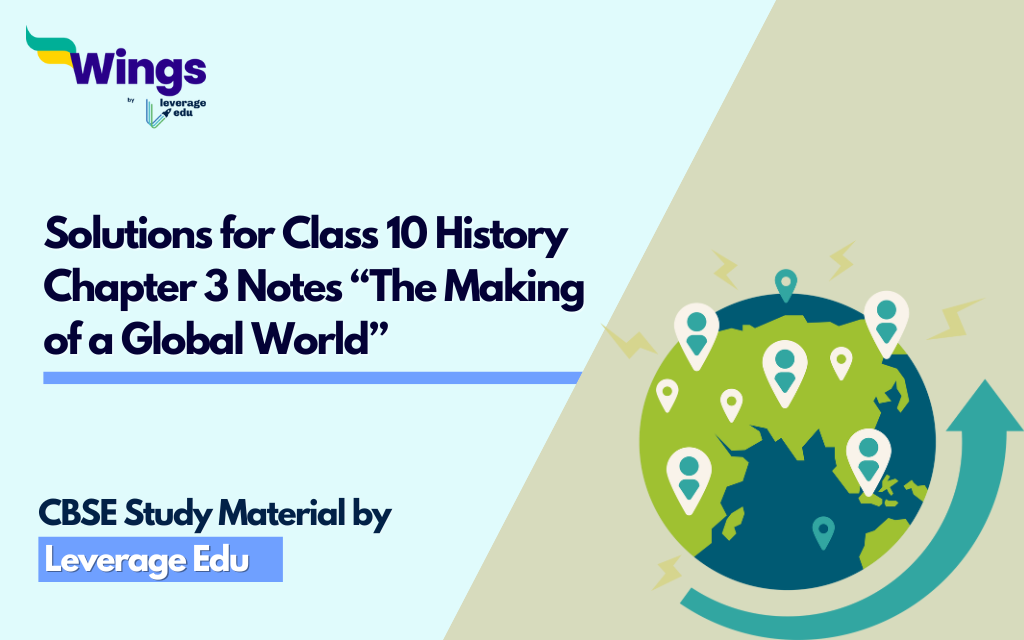Solutions for Class 10 History Chapter 3 Notes ¨The Making of a Global World¨ aims to provide students with insightful solutions. Our subject matter experts have offered simple and accurate answers for the exercises in the history book ¨India and the Contemporary World-II.¨
Solutions for Class 10 History Chapter 3 Notes ¨The Making of a Global World¨are designed in an easy-to-understand manner to help students grasp the topics easily. Students can use these varieties of NCERT solutions and learn more about these interesting topics comprehensively.
We hope that the Solutions for Class 10 History Chapter 3 Notes ¨The Making of a Global World¨ will be helpful for the students.
Check out CBSE Class 10 History Chapters Solutions
Important Questions and Answers of Solutions for Class 10 History Chapter 3 Notes ¨The Making of a Global World¨
| Question: What is globalisation? Answer: Globalisation refers to the process of increased interconnectedness and integration of economies, cultures, and societies across the world. Question: How did the Silk Routes contribute to global trade? Answer: The Silk Routes facilitated trade and cultural exchange between Asia and Europe, enabling the flow of goods like silk and spices, and fostering cultural diffusion. Question: What were the impacts of European colonisation on global trade? Answer: European colonisation redirected global trade flows towards Europe, exploiting resources from colonies and creating new trade networks worldwide. Question: Explain the significance of the Industrial Revolution in the context of globalisation. Answer: The Industrial Revolution accelerated globalisation by increasing production efficiency, facilitating mass production, and stimulating trade and urbanisation. Question: How did technological advancements like railways and steamships impact global trade? Answer: Technologies such as railways and steamships reduced transportation costs, sped up trade routes, and facilitated the global movement of goods and people. Question: What role did the Bretton Woods Institutions play in post-war global reconstruction? Answer: The Bretton Woods Institutions (IMF and World Bank) provided financial stability, and reconstruction aid, and promoted economic cooperation among nations after World War II. Question: What were the consequences of globalisation for India? Answer: Globalisation brought both opportunities and challenges for India, including economic growth and cultural exchange, but also issues like inequality and environmental degradation. Question: How did the Great Depression impact global economies? Answer: The Great Depression led to economic downturns worldwide, affecting trade and employment and prompting governments to adopt protectionist measures. Question: What factors contributed to the rise of multinational corporations (MNCs)? Answer: Factors like technological advancements, liberalization of trade policies, and global integration encouraged the growth of MNCs, influencing global economies. Question: What lessons can be drawn from the history of globalisation? Answer: The history of globalisation highlights the importance of economic interconnectedness, technological innovation, and the need for global cooperation in addressing challenges. |
Write in Brief
| 1. Give two examples of different types of global exchanges that took place before the twentieth century, choosing one example from Asia and one from the Americas. Ans. Example from Asia: Silk Routes facilitated trade and cultural exchange between China and the Roman Empire, exchanging silk and spices. Example from the Americas: Columbian Exchange introduced new crops like maize and potatoes to Europe, while Europe brought diseases like smallpox to the Americas. 2. Explain how the global transfer of disease in the pre-modern world helped in the colonisation of the Americas. Ans. The global transfer of diseases like smallpox devastated Indigenous populations in the Americas, weakening resistance to European conquest and facilitating colonisation. 3. Write a note to explain the effects of the following: a) The British government’s decision to abolish the Corn Laws. b) The coming of rinderpest to Africa. c) The death of men of working-age in Europe because of the World War. d) The Great Depression on the Indian economy. e) The decision of MNCs to relocate production to Asian countries. Ans. a) Abolishing the Corn Laws in Britain lowered food prices, benefiting consumers but hurting British farmers. b) Rinderpest in Africa devastated cattle populations, impacting livelihoods and facilitating European colonial control. c) World War I led to a significant loss of working-age men in Europe, affecting labor supply and economic stability. d) The Great Depression caused a sharp decline in Indian trade and agricultural prices, exacerbating poverty and unemployment. e) MNCs relocating production to Asian countries like China and India reduced costs and expanded global markets, impacting local economies. 4. Give two examples from history to show the impact of technology on food availability. Ans. Two examples from history show the impact of technology on food availability. The Green Revolution introduced high-yield crop varieties, increasing food production in developing countries. Refrigeration technology enabled global transportation of perishable foods, expanding food choices and availability worldwide. 5. What is meant by the Bretton Woods Agreement? Ans. The Bretton Woods Agreement established a new international monetary system after World War II, creating the IMF and World Bank to stabilize exchange rates and facilitate global economic cooperation. |
Also Read: NCERT Solutions and Notes for Class 8 English Honeydew Chapter 5: The Summit Within (Free PDF)
Related Reads:
Follow Leverage Edu for complete study materials on CBSE Notes and NCERT Solutions Class 10 Social Science.
 One app for all your study abroad needs
One app for all your study abroad needs














